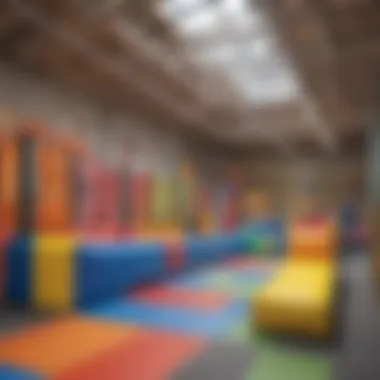Understanding Soft Play: Benefits and Design Insights


Intro
Soft play areas have become a common sight in many communities, offering a unique blend of entertainment and learning for children. These spaces are designed to be welcoming and engaging, encouraging young minds to explore, play, and learn in a safe environment. Beyond just a place to let off steam, soft play environments provide essential developmental benefits, enhancing social, physical, and cognitive skills. In this journey through understanding soft play, we will delve into its advantages, the principles of effective design, and its profound impact on child development.
In the following sections, we explore interactive learning games, educational topics, practical tips for parents and educators, and creative DIY projects that tie into the soft play concept. Each of these elements plays a role in nurturing creativity and fostering a positive learning experience for children. As we navigate this landscape of play, let’s uncover the layers that make soft play not just a passing trend, but a meaningful part of childhood development.
Defining Soft Play
Soft play refers to play areas designed specifically for children, often comprising padded structures and soft materials that allow for safe and stimulating environments. Understanding this concept is paramount, as it opens the door to numerous benefits for child development, from fostering physical capabilities to enhancing social interactions. By grasping what soft play truly entails, parents and caregivers can create enriching spaces that support children’s growth in a multi-faceted way.
Origin and Evolution
The origins of soft play can be traced back to the late 20th century when there was a growing recognition of the need for safer play environments for children. Prior to this, most play areas featured hard surfaces and equipment that posed various risks. The shift began when educators, psychologists, and parents alike started to realize that children learn best through playful exploration.
Soft play equipment evolved from traditional playground settings to include elements that promote free movement without the fear of injury. Early soft play areas were often inflatable structures, but as the design advanced, manufacturers began to incorporate foam shapes, climbable cushions, and more intricate layouts that stimulate creativity. From community centers to commercial play facilities, the rise of soft play setups has revolutionized how children engage with their environment, allowing for imaginative play while reducing injury risks.
Key Characteristics
Soft play areas distinguish themselves through several defining features that uphold their main premise: safety and engagement.
- Safety Features: The use of padded materials and soft surfaces minimizes the risk of injuries during joyful tumbles and falls. High-quality foam is often used to create obstacles or structures that encourage exploration without compromise on safety.
- Diverse Equipment: Specialized structures like climbing walls, slides, and ball pits come together to create engaging play experiences. Each piece serves a dual purpose: entertainment and skill development.
- Age Appropriateness: Many soft play environments are designed with age-specific sections, ensuring that children engage with developmentally suitable challenges.
- Sensory Experiences: Various textures, colors, and shapes engage children’s senses, promoting exploration and discovery. Sensory stimulation is crucial in early developmental stages.
- Social Interaction Areas: Clear spaces for gathering around play equipment encourage communication and collaboration among children, making social skills as much a part of play as physical skills.
In summary, defining soft play provides essential insights into its contributions to child development. By cherishing the origins and characteristics, stakeholders can better appreciate how these environments encourage growth and learning.
Benefits of Soft Play
The relevance of soft play environments cannot be overstated. They serve as an essential space where children can thrive physically, socially, and mentally. When exploring the multifaceted benefits of soft play, it becomes clearer how these recreational areas foster development in unique ways that surely accommodate diverse needs.
Physical Development
Motor Skills
Motor skills encompass a range of bodily movements. In soft play areas, children engage their core, limbs, and coordination extensively. Not merely a right of passage for toddlers, mastering motor skills is crucial for all growing kids. Activities such as climbing up cushioned structures, crawling through tunnels, and bouncing off soft surfaces promote not only muscle strength but also balance and precision. The tactile interactions encourage children to discover their physical limits and develop a sense of accomplishment after overcoming challenges. Motor skills play are arguably a popular choice here since they align so well with natural play tendencies. Each climb, jump, and stretch translates directly into physical growth, which is vital for a well-rounded childhood experience.
Coordination
Coordination hinges on multiple factors, such as vision, balance, and timing. In a soft play setting, coordination is not just taught; it's instinctively learned through play. Jumping from one space to another or balancing on walkways challenges children to synchronize their movements. Strong coordination is essential for daily activities, whether it's running, catching a ball, or even writing. Thus, soft play areas provide a fantastic backdrop for developing these skills. This playful context eases the pressure often felt in structured environments, making it more appealing for kids to explore and test their capabilities.
Social Skills
Interaction
The essence of interaction within soft play is what makes these spaces so inviting to children. Engaging with peers in a dynamic, stimulating environment allows kids to practice essential conversational skills and learn the nuances of social behavior. Examples abound: whether negotiating sharing toys or developing friendly rivalries while racing to the top of a slide, these interactions forge connections that last outside of play. The unique feature of fostering real-time communication underlines the importance of spontaneous play. Children learn to express needs and emotions while also navigating the unpredictabilities of group dynamics, amplifying their social education without them even realizing it.
Teamwork
Teamwork is foundational for social development, and soft play fosters this through various activities. Children often work together to overcome obstacles, be it building a fortress out of soft blocks or coordinating an exit route through an inflatable maze. By achieving goals together, they not only achieve moments of joy but also grasp the importance of shared responsibility. Teamwork teaches empathy—it allows them to understand others’ feelings and viewpoints while making way for collaboration rather than competition. A crucial takeaway here is that soft play settings cultivate a community atmosphere where kids regularly practice teamwork, which later helps them thrive in school and social situations.
Cognitive Growth
Problem Solving
Encounters in soft play areas require kids to think on their feet, thereby enhancing problem-solving skills. Whether figuring out how to conquer a climbing wall or deciding the best way to traverse a maze, children engage in critical thinking. The pleasure derived from these experiences adds an invaluable layer of learning. Children strengthen their analytical skills as they weigh out options and consequences. Thus, soft play is an enticing medium that subtly pushes children to devise effective solutions to spontaneous challenges.
Decision Making


Decision-making ability shines through during soft play. Each time a child chooses between two different paths in a play structure, there lies an opportunity to develop this essential skill. It's not just about play; these decisions mirror real-world complexities, preparing them for life situations that require quick thinking. The unique feature of a soft play area is its safe space to experiment without significant risks. The benefits of this are multifold—the earlier kids start making decisions, the more confident they become in their choices later on.
"Soft play environments blend enjoyment with growth, where every jump, tumble, and giggle contributes to a child's development."
Overall, the various benefits of soft play create an ecosystem conducive to crucial developments across multiple facets of a child's upbringing. In a world that can sometimes feel increasingly complicated, these areas provide a foundation for safe, unrestricted exploration and learning.
Types of Soft Play Environments
Understanding the different types of soft play environments is crucial for parents, caregivers, and educators as they seek to provide optimal spaces for children to explore and learn. Each environment has its unique features, challenges, and benefits that contribute to a child's physical, social, and emotional development. Below, we delve into three primary types of soft play environments: indoor play centers, outdoor play areas, and home soft play solutions.
Indoor Play Centers
Indoor play centers are often vibrant arenas filled with a variety of elements designed to engage young imaginations. These centers typically feature structures like soft climbing walls, ball pits, and obstacle courses that encourage movement and exploration. One of the primary advantages of indoor play centers is their ability to offer a controlled environment irrespective of weather conditions. Here, children can engage in active play even when the skies are gray.
Factors to consider include:
- Safety: Most centers prioritize safety with padded flooring and properly designed equipment.
- Supervision: Staff members are usually trained to oversee activities, ensuring children's well-being during play.
- Social Interaction: These settings not only promote physical skills but also social skills as children learn to navigate friendships and group dynamics.
Indoor play centers serve as excellent venues for birthday parties or group gatherings, providing a space where fun and development go hand in hand.
Outdoor Play Areas
Outdoor play areas provide a refreshing alternative to indoor centers. These settings can range from playgrounds in local parks to nature-oriented play areas featuring natural elements like logs and sand. The outdoor environment offers a unique opportunity for children to connect with nature, which is a vital aspect of children's development.
Considerations for outdoor play areas include:
- Exploratory Learning: Children can use natural materials in imaginative ways, promoting cognitive and imaginative skills.
- Physical Activity: The open space encourages running, jumping, and climbing, promoting overall fitness.
- Social Skills: As children engage in outdoor play, they often form teams and work together in games, enhancing social interaction.
However, it’s essential to keep in mind factors such as weather, supervision, and safety features like soft grass or rubber mats under play structures to prevent injuries.
Home Soft Play Solutions
Home soft play solutions cater specifically to families looking to create an engaging play space in their own backyards or living rooms. These solutions can include items like soft play mats, inflatable structures, and modular play equipment that can be easily arranged or adjusted as children grow.
Characterizing features of home solutions:
- Customizability: Parents can tailor play areas to their child’s age and interests.
- Safety: It's easier for parents to monitor and ensure a safe play environment within their home.
- Convenience: Having a dedicated area at home encourages frequent physical activity without needing to travel elsewhere.
Moreover, home soft play solutions ease the pressure on parents dealing with logistics, and they can foster a sense of belonging as children enjoy playtime in a familiar, comfortable space.
"Creating inviting environments for play doesn't just enhance physical activity; it nurtures emotional well-being and sparks creativity in children. Different settings offer diverse experiences that contribute to well-rounded development."
Design Principles of Soft Play Areas
When considering soft play environments, the design principles play a pivotal role in ensuring that these spaces are not only engaging but also safe and conducive to development. A well-thought-out design can encourage exploration, promote physical activity, and foster social interactions among children. The right design principles can create a balance between stimulating play and needed safety measures, allowing kids to roam freely while parents can breathe easier.
Safety Considerations
Material Choices
A major aspect of safety in soft play areas is the material choices used in construction. Choosing the right materials can greatly influence both safety measures and the overall experience. For instance, foam is commonly used due to its shock-absorbing properties, minimizing the risk of injury during falls.
- Key characteristic: Foam materials are soft yet durable, able to withstand rough play without degrading.
- Why it's beneficial: Using foam helps maintain a safe environment for children to explore, run, and jump.
- Unique features: Many foam materials come in bright colors and are easy to clean, making them not just safe, but also visually appealing.
- Advantages/Disadvantages: While foam allows for safe play, it's essential to ensure that it meets safety standards. With lower quality materials, the risk of decomposition can increase, making regular inspections a necessity.
Surface Design
The design of surfaces in soft play areas is equally significant. Proper surface design is crucial for both functionality and safety. Slippery floors can pose risks, especially when children are running around energetically.


- Key characteristic: A textured surface helps enhance grip, preventing slips and falls.
- Why it's a popular choice: Textured surfaces give children more confidence to move around without the fear of falling.
- Unique features: Surfaces can be designed with additional cushioning to minimize impact if a child does fall.
- Advantages/Disadvantages: While cushioning is advantageous, it's important to regularly clean these surfaces to maintain hygiene. Failure to do so can lead to hazards, especially if spills go unnoticed.
Age Appropriateness
Understanding age appropriateness in soft play design is fundamental. Not all features are suitable for every age group, and creating distinct areas catering to various developmental stages helps in providing tailored activities for children. For instance, a toddler area might include gentle slopes and smaller structures, while zones for older kids can involve climbing challenges and interactive elements.
Accessibility for All
Creating soft play environments that are accessible for all children is a design necessity. This includes thoughtful planning that considers children with disabilities or mobility challenges. Ramps, wide pathways, and leveled surfaces can help ensure all children can enjoy the space. It's about breaking down physical barriers so every child can participate and benefit from the joy of play. Incorporating sensory materials can also enhance the experience for children who may engage differently with their surroundings.
"Designing for accessibility is not just adding features; it’s about integrating a mindset that considers all abilities."
Through careful consideration of these design principles, soft play areas can significantly improve the experience for children, ensuring a delightful mix of fun, learning, and safe encounter.
Psychological Implications of Soft Play
Soft play environments offer more than merely a space for kids to burn off energy; they play a crucial role in the overarching psychological development of children. The laughter, smiles, and spontaneous interactions in these vibrant spaces contribute significantly to emotional balance and creative expression. Understanding the psychological implications of soft play provides insights into how these areas can aid in emotional stability and an outlet for creativity.
Emotional Well-being
Stress Relief
Stress relief in children may seem like an abstract concept, but it triggers something fundamental in their overall well-being. The carefree atmosphere found in soft play zones allows children to escape daily pressures, no matter how small they might be. A solid chuckle amidst bouncing balls and climbing structures can lighten their mood profoundly.
One key characteristic of stress relief in soft play is the sheer freedom to explore. Instead of adhering to strict rules, kids can engage in imaginative play without constraints, which can be enormously beneficial. This lack of pressure helps reduce anxiety and fosters a sense of calm.
The unique aspect of this stress relief is how social interactions come into play. As children interact with peers, they share experiences, conquer challenges, and navigate social dynamics, all of which help manage stress in an organic manner. However, the downside is that not all children thrive in such settings; shy or anxious ones may feel overwhelmed in busy environments. Thus, while the benefits of stress relief in soft play are manifold, understanding each child's temperament is essential for maximizing this advantage.
Confidence Building
Building confidence is another psychological benefit derived from engaging in soft play. It’s fascinating to see how the little ones grow in confidence with each leap and tumble they take. This aspect is about more than just physical skill; it's largely tied to their self-image and assertiveness.
One vital characteristic of the confidence building process is the achievement of small victories — be it climbing to the top of a slide or simply managing to navigate through a tricky obstacle. These achievements, no matter how minor, empower kids, fostering a mindset of ‘I can do this’. The immediate feedback and encouragement from peers can amplify this growth, something that structured educational settings sometimes struggle to provide.
The unique feature of confidence building in soft play is its fluid nature. Children are constantly surrounded by opportunities to try, fail, and retry, which cumulatively chips away at their self-doubts and replaces them with a can-do attitude. On the flip side, some children might take longer to build up that confidence, facing challenges that can dishearten them in the process. Nonetheless, observing children as they blossom in confidence makes it clear how vital soft play environments are for emotional health.
Creativity and Imagination
Imagination often takes center stage in the world of soft play. With colorful structures, imaginative designs, and freely available toys, children have the freedom to weave their own stories and adventures.
The role that creativity plays in child development cannot be understated. As children explore their surroundings, they learn to create scenarios and engage their imaginations, which fuels cognitive processes. Whether pretending to be a pirate on a ship or an astronaut exploring the cosmos, the possibilities are endless.
Furthermore, this imaginative play not only sparks joy but also contributes to the development of problem-solving skills. Children must often navigate unpredictable play environments, and in doing so, they learn to think on their feet, pivoting as their imaginative story unfolds.
Educational Aspects of Soft Play
When considering the overall growth and development of children, soft play emerges as a critical component. It is not just a place for kids to blow off steam; it's pivotal for nurturing various skills that influence lifelong learning and character development. From enhancing cognitive functions to boosting social skills, the educational aspects of soft play environments are manifold.
Learning Through Play
Concept Development
Concept development serves as the backbone of a child's understanding of the world. In the context of soft play, it allows children to explore new ideas and concepts through tangible experiences. Here, play becomes an active learning method; kids interact with varying shapes, sizes, and colors, helping them grasp basic concepts such as patterns and categorization.
The key characteristic of concept development is its hands-on nature. By manipulating play equipment and engaging in pretend play, children solidify abstract ideas into concrete understandings. This is an advantageous approach; it caters to different learning paces, allowing children to absorb information in a manner that feels natural and enjoyable.


One unique feature of this learning style is its versatility. Concept development is not limited to structured lessons. Rather, it offers an organic integration of learning into playtime, making it a popular choice among educators and parents alike. The flexibility of this model means that even unstructured play can yield significant conceptual gains. However, it's worth noting that without a little guidance, some kids may veer off track, making it important for caregivers to strike a balance between free play and educational input.
Language Skills
Language acquisition is another critical area positively impacted by soft play. A vibrant auditory landscape accompanies these playful explorations. From hearing sounds of laughter to bursts of imaginative dialogue during pretend games, the environment fosters language-rich interactions.
The enriching characteristic of this setting is that it encourages spontaneous conversation. When in a group, children often engage in discussions, share stories, or even negotiate roles in a game. This peer-to-peer interaction accelerates vocabulary building and enhances comprehension skills. It is a beneficial method for language development, as it occurs in a low-pressure, supportive setting.
A unique aspect of developing language skills within soft play is the diversity of vocabulary that may arise. Children are exposed to new words related to different activities and actions they engage in, be it climbing, sliding, or building. Yet, there can be challenges as well; not all children may participate equally, and some may feel shy or hesitant to speak up in a lively crowd. Fostering an inclusive atmosphere is essential to ensure every child feels empowered to express themselves.
Structured vs. Unstructured Play
Determining the type of play that best benefits children is crucial. Structured play offers predetermined activities and clear instructions which can indeed yield targeted outcomes. However, unstructured play, characterized by its free-form nature, grants children the freedom to explore and develop their creativity. Both types have significant educational value.
Taking a step back, it’s clear that both structured and unstructured play have roles to play in educational settings. Parents and educators can find themselves at the crossroads of choosing the best approach, maybe blending elements of both for a balanced experience.
"Children learn best when they have the freedom to navigate their play environment, discovering and experimenting on their own terms."
In summary, the educational aspects of soft play lay a solid foundation for concept and language development, empowering children to grow both intellectually and socially.
Incorporating Soft Play into Daily Life
Incorporating soft play into daily life signifies embracing a philosophy that acknowledges the profound impact of play on child development. For children, play is not merely a pastime; it’s a critical avenue for learning and growth. This section will delve into how integrating soft play can significantly enhance a child's routine, providing structure and flexibility that can be tailored to individual needs and circumstances.
Integrating Soft Play into Routine
Creating a routine that includes soft play doesn’t have to feel like pulling teeth. It can actually be quite simple and enjoyable. Here are some methods to effectively weave soft play into your daily life:
- Scheduled Playtimes: Designate specific times during the day solely for soft play, similar to how meal times are often structured. This could be right after school or during weekends, letting the child know it’s an anticipated part of the day.
- Interactive Sessions: Mix soft play with other activities. For example, after storytime, you can encourage a soft play session that relates to the story. This not only keeps them engaged but also enriches their understanding of the themes.
- Flexible Play Spots: Utilize different areas of the home—turn the living room into a mini soft play zone on weekends. Arranging cushions, soft mats, and toys can create an inviting environment to explore, fostering creativity while also promoting independence in play.
In this way, integrating soft play not only becomes an enjoyable routine but also fosters a sense of emotional security, essential for child development.
Soft Play in Care Settings
Soft play also holds an invaluable place in care settings, whether that be daycare facilities, preschools, or even in home care environments. Such spaces must recognize the benefits of soft play and implement it as part of their engagement strategies. This includes:
- Multi-Sensory Stimulation: Environments enhance a child's sense of touch, sight, and even sound. Using brightly colored soft play equipment, textured surfaces, and sound features offers a broader scope for sensory exploration, essential for cognitive and emotional growth.
- Safe Social Interaction: In care settings, soft play areas facilitate social skills. Children learn to communicate, share, and resolve conflicts through play. Such interactions are crucial for their social development, preventing feelings of isolation and promoting teamwork.
- Inclusivity: Soft play facilities can be designed to cater to children of varied abilities. Ensuring that all children can participate equally is vital. Accessible equipment not only promotes inclusion but also fosters empathy and understanding among peers.
"Play is the highest form of research." – Albert Einstein. Incorporating soft play into daily routines and care settings can remarkably enrich child development, creativity, and social interaction.
Soft play should not be seen merely as an optional element of childhood, but rather a fundamental aspect of nurturing a child’s overall well-being.
The Future of Soft Play
Soft play has long been a vital component of childhood development, providing a safe and engaging environment for children to learn, explore, and interact. As we look ahead, it becomes essential to consider how soft play environments will evolve to meet the changing needs of families, educators, and, most importantly, the children themselves. The future of soft play is not just about expanding physical spaces; it's also about innovation, addressing educational needs, and fostering an environment that seamlessly integrates play with technology for holistic development.
Technological Innovations in Soft Play
In our fast-paced, tech-driven world, technology is seeping into every corner, including playspaces designed for children. The introduction of technology in soft play areas can significantly enhance the play experience, transforming traditional physical elements into more engaging, interactive adventures that grow with the child. For instance, think of soft play areas equipped with augmented reality games that not only entertain but also educate. Children can see animated characters or challenges superimposed on their surroundings, making it possible for them to learn essential skills like counting or color recognition while climbing through a foam obstacle course.
Furthermore, wearable technology could offer real-time feedback on a child's activity levels, encouraging physical engagement while keeping parents informed through an app. This innovation not only provides reassurance but also supports interventions when necessary, promoting a balanced approach to children's play and health. Technologies that promote longevity in learning are essential as well, meaning that soft play environments should consistently adapt to emerging trends to sustain relevance in children's developmental journeys.
Trends in Child Development and Soft Play
There lies a significant link between evolving educational trends and the design of soft play spaces. As teaching philosophies shift towards holistic development, there's a growing recognition that play is fundamental to learning. Future soft play spaces are likely to incorporate elements that align with various learning styles—auditory, visual, and kinesthetic—offering children multiple ways to learn through play rather than segregating education from recreation.
Nature-inspired designs are also gaining traction. Children today are more exposed to screens than ever before, leading to a disconnect with the natural environment. Soft play areas that integrate organic shapes, outdoor elements, and sensory experiences will encourage exploration and appreciation of nature while promoting physical activity.
Also, the acknowledgment of social-emotional learning is another trend shaping the future. Spaces that allow for cooperative play, role-playing, and peer interaction can significantly enhance social skills and emotional intelligence. Considering the increasing focus on mental health, facilities must provide environments that encourage sharing, empathy, and team dynamics.
"The best way to ensure children grow into healthy, well-adjusted individuals is by understanding their need for both play and emotional connection, making these elements fundamental in soft play design."
As we progress into the future, the responsibility for creating engaging, innovative soft play environments will rest on our collective shoulders. Parents, educators, and designers must collaborate to ensure that our young ones not only learn and grow through play but also develop the attributes needed to navigate an ever-changing world.















